Geochronology, Oxidization State and Source of the Daocheng Batholith, Yidun Arc: Implications for Regional Metallogenesis
Abstract
:1. Introduction
2. Geological Setting
3. Samples and Analytical Methods
3.1. Whole-Rock Major and Trace Elements
3.2. LA-ICP-MS Zircon U–Pb Dating and In Situ Trace Element Analysis of Zircon
3.3. Zircon Lu–Hf Isotope Analysis
4. Results
4.1. Major and Trace Elements Geochemistry
4.2. Zircon U–Pb Geochronology
4.3. Zircon Lu–Hf Isotopes
4.4. Zircon Trace Elements
5. Discussion
5.1. Petrogenesis of the Dacocheng Batholith
5.2. Magma Mixing
5.3. Implications for Regional Metallogenic Distinctions Between NYA and SYA
6. Conclusions
- (1)
- The host granodiorite and MMEs from the Daocheng batholith were formed at ca. 215 Ma and ca. 214 Ma, respectively; they were coeval within errors, indicating that they were the products of contemporaneous magmatic activity in the Late Triassic.
- (2)
- The Late Triassic Daocheng granodiorite is metaluminous to just peraluminous, high-K calc-alkaline I-type granite, and derived from the partial melting of Mesoproterozoic igneous arc lower crust.
- (3)
- The abundant MMEs occurred mainly in granodiorite and K-feldspar megacrystic granite and had a typical granular texture. The MMEs were characterized by quenched apatite, quartz eyes and the contents of MgO, Al2O3 and Fe2O3 were negatively correlated with SiO2 content. The MMEs were generated by the incomplete mixing of the mafic magma with felsic magma.
- (4)
- The Daocheng granodiorite had much lower zircon Ce4+/Ce3+ (average of 3.53) and fO2 values (average of ∆FMQ = −10.84) than those of ore-bearing quartz monzonite porphyry (average of Ce4+/Ce3+ = 52.10; ∆FMQ = 2.8) in the Pulang copper deposit. Thus in this comparative study it was clear that during the Late Triassic in the Yidun Arc, the high oxygen fugacity of the magma was conducive to mineralization.
Supplementary Materials
Author Contributions
Funding
Acknowledgments
Conflicts of Interest
References
- Deng, J.; Wang, Q.F.; Li, G.J.; Santosh, M. Cenozoic tectono-magmatic and metallogenic processes in the Sanjiang region, southwestern China. Earth Sci. Rev. 2014, 138, 268–299. [Google Scholar] [CrossRef]
- Deng, J.; Wang, Q.F.; Li, G.J.; Li, C.S.; Wang, C.M. Tethys tectonic evolution and its bearing on the distribution of important mineral deposits in the Sanjiang region, SW China. Gondwana Res. 2014, 26, 419–437. [Google Scholar] [CrossRef]
- He, W.Y.; Mo, X.X.; He, Z.H.; White, N.C.; Chen, J.B.; Yang, K.H.; Wang, R.; Yu, X.H.; Dong, G.C.; Huang, X.F. The Geology and Mineralogy of the Beiya Skarn Gold Deposit in Yunnan, Southwest China. Econ. Geol. 2015, 110, 1625–1641. [Google Scholar] [CrossRef]
- He, W.Y.; Xie, S.X.; Liu, X.D.; Gao, X.; Xing, Y.L. Geochronology and geochemistry of the Donglufang porphyry-skarn Mo–Cu deposit in the southern Yidun Terrane and their geological Significances. Geosci. Front. 2018, 9, 1433–1450. [Google Scholar] [CrossRef]
- Yang, L.Q.; Deng, J.; Gao, X.; He, W.Y.; Meng, J.Y.; Santosh, M.; Yu, H.J.; Yang, Z.; Wang, D. Timing of formation and origin of the Tongchanggou porphyry-skarn deposit: Implications for Late Cretaceous Mo–Cu metallogenesis in the southern Yidun Terrane, SE Tibetan Plateau. Ore Geol. Rev. 2017, 81, 1015–1032. [Google Scholar] [CrossRef]
- Yang, L.Q.; Deng, J.; Dilek, Y.; Meng, J.Y.; Gao, X.; Santosh, M.; Wang, D.; Yan, H. Melt source and evolution of I-type granitoids in the SE Tibetan Plateau: Late Cretaceous magmatism and mineralization driven by collision-induced transtensional tectonics. Lithos 2016, 245, 258–273. [Google Scholar] [CrossRef]
- Yang, L.Q.; He, W.Y.; Gao, X.; Shu, Q.H. Multiple Mesozoic porphyry-skarn Cu (Mo–W) systems in Yidun Terrane, east Tethys: Constraints from zircon U–Pb and molybdenite Re-Os geochronology. Ore Geol. Rev. 2017, 90, 813–826. [Google Scholar] [CrossRef]
- Gao, X.; Yang, L.Q.; Meng, J.Y.; Zhang, L.J. Zircon U–Pb, molybdenite Re–Os geochronology and Sr–Nd–Pb–Hf–O–S isotopic constraints on the genesis of Relin Cu–Mo deposit in Zhongdian, Northwest Yunnan, China. Ore Geol. Rev. 2017, 91, 945–962. [Google Scholar] [CrossRef]
- Yang, L.Q.; Gao, X.; He, W.Y. Late Cretaceous porphyry metallogenic system of the Yidun arc, SW China. Acta Petrol. Sin. 2015, 31, 3155–3170, (In Chinese with English Abstract). [Google Scholar]
- Yang, L.Q.; He, W.Y.; Gao, X.; Xie, S.X.; Yang, Z. Mesozoic multiple magmatism and porphyry–skarn Cu–polymetallic systems of the Yidun Terrane, Eastern Tethys: Implications for subduction- and transtension-related metallogeny. Gondwana Res. 2018, 62, 144–162. [Google Scholar] [CrossRef]
- Hou, Z.Q.; Yang, Y.Q.; Qu, X.M.; Huang, D.H.; Lü, Q.T.; Wang, H.P.; Yu, J.J.; Tang, S.H. Tectonic evolution and mineralization systems of the Yidun Arc Orogen in Sanjiang Region, China. Acta Geol. Sin. 2004, 78, 109–120, (In Chinese with English Abstract). [Google Scholar]
- Deng, J.; Wang, C.M.; Zi, J.W.; Xia, R.; Li, Q. Constraining subduction-collision processes of the Paleo-Tethys along the Changning–Menglian Suture: New zircon U-Pb ages and Sr–Nd–Pb–Hf–O isotopes of the Lincang Batholith. Gondwana Res. 2017, 62, 75–92. [Google Scholar] [CrossRef]
- Li, W.C.; Pan, G.T.; Hou, Z.Q. Metallogenic and Exploration Techniques of Multi–islandearc Basin–Collision Orogenic Belt in Southwest of the “Three Rivers”; Geological Publishing House: Beijing, China, 2010; pp. 1–107. (In Chinese) [Google Scholar]
- Gao, X.; Yang, L.Q.; Orovan, E.A. The lithospheric architecture of two subterranes in the eastern Yidun Terrane, East Tethys: Insights from Hf–Nd isotopic mapping. Gondwana Res. 2018, 62, 127–143. [Google Scholar] [CrossRef]
- Deng, J.; Wang, Q.F.; Li, G.J. Tectonic evolution, superimposed orogeny, and composite metallogenic system in China. Gondwana Res. 2018, 50, 216–266. [Google Scholar] [CrossRef]
- Zhang, R.G.; Gao, X.; Yang, L.Q. Identification of magma mixing: A case study of the Daocheng batholith in the Yidun Arc. Adv. Earth Sci. 2018, 33, 1058–1074. [Google Scholar]
- He, D.F.; Zhu, W.G.; Zhong, H.; Ren, T.; Bai, Z.J.; Fan, H.P. Zircon U–Pb geochronology and elemental and Sr–Nd–Hf isotopic geochemistry of the Daocheng granitic pluton from the Yidun Arc, SW China. J. Asian Earth Sci. 2013, 67–68, 1–17. [Google Scholar] [CrossRef]
- Wang, N.; Wu, C.L.; Qin, H.P. Mineralogical, Geochemical Features of Typical Mesozoic Granites in the Yidun Arc, Western Sichuan and a Discussion on the Magma Origin. Geol. Rev. 2017, 63, 981–1000, (In Chinese with English Abstract). [Google Scholar]
- Hou, Z.Q.; Qu, X.M.; Zhou, J.R.; Yang, Y.Q.; Huang, D.H.; Lü, Q.T.; Tang, S.H.; Yu, J.J.; Wang, H.P.; Zhao, J.H. Collision–orogenic processes of the Yidun Arc in the Sanjiang region: Record of granites. Acta Geol. Sin. 2001, 75, 484–497, (In Chinese with English Abstract). [Google Scholar]
- Reid, A.; Wilson, C.; Liu, S.; Pearson, N.; Belousova, E. Mesozoic plutons of the Yidun Arc, SW China: U/Pb geochronology and Hf isotopic signature. Ore Geol. Rev. 2007, 31, 88–106. [Google Scholar] [CrossRef]
- Wang, N.; Wu, C.L.; Qin, H.P.; Lei, M.; Guo, W.F.; Zhang, X.; Chan, H.J. Zircon U–Pb geochronology and Hf isotopic characteristics of the Daocheng granite and Haizishan granite in the Yidun Arc, Western Sichuan, and their geological significance. Acta Geol. Sin. 2016, 90, 3227–3245, (In Chinese with English Abstract). [Google Scholar]
- Wu, T.; Xiao, L.; Wilde, S.A.; Ma, C.Q.; Zhou, J.X. A mixed source for the Late Triassic Garzê-Daocheng granitic belt and its implications for the tectonic evolution of the Yidun arc belt, eastern Tibetan Plateau. Lithos 2017, 288–289, 214–230. [Google Scholar] [CrossRef]
- Liu, S.W.; Wang, Z.Q.; Yan, Q.R.; Zhang, D.H.; Wang, J.G.; Yang, B.; Gu, L.B.; Zhao, F.S. Indosinian tectonic setting of the southern Yidun Arc: Constraints from SHRIMP zircon chronology and geochemistry of Dioritic porphyrites and granites. Acta Geol. Sin. 2006, 80, 387–399, (In Chinese with English Abstract). [Google Scholar]
- Wang, Q.W.; Wang, K.M.; Kan, Z.Z. Granite and Its Metallogenic Series of Western Sichuan Province; Geological Publishing House: Beijing, China, 2008. (In Chinese) [Google Scholar]
- Peng, T.P.; Zhao, G.C.; Fan, W.M.; Peng, B.X.; Mao, Y.S. Zircon geochronology and Hf isotopes of Mesozoic intrusive rocks from the Yidun terrane, eastern Tibetan Plateau: Petrogenesis and their bearings with Cu mineralization. J. Asian Earth Sci. 2014, 80, 18–33. [Google Scholar] [CrossRef]
- Cao, D.H.; Wang, A.J.; Li, W.C.; Wang, G.S.; Li, R.P.; Li, Y.K. Magma mixing in the Pulang Copper Deposit: Evidence from Petrology and Element Geochemistry. Acta Petrol. Sin. 2009, 83, 166–175, (In Chinese with English Abstract). [Google Scholar]
- Wang, P.; Dong, G.C.; Dong, M.L.; Li, Y.P.; Xu, Y.M.; Pan, Y.N.; Chen, W.; Wu, Z.C. Magma mixing of the Cuojiaoma Batholith in the Yindun Arc: Evidence from mafic microgranular enclaves. Acta Petrol. Sin. 2017, 33, 2535–2547, (In Chinese with English Abstract). [Google Scholar]
- Gao, X.; Yang, L.Q.; Zhang, R.G.; Meng, J.Y. Nature and origin of Mesozoic granitoids and associated mineralization in the Sanjiang Tethys Orogeny, SW China: The Xiuwacu complex example. Int. Geol. Rev. 2019, 61, 795–820. [Google Scholar] [CrossRef]
- Li, W.C.; Zeng, P.Z.; Hou, Z.Q.; Noel, C.W. The Pulang copper deposit and associated felsic intrusions in Yunnan province, Southeast China. Econ. Geol. 2011, 106, 79–92. [Google Scholar]
- Zhang, R.G.; He, W.Y.; Gao, X.; Li, M.M. Magma mixing of the Daocheng batholith of western Sichuan: Mineralogical evidences. Geosci. Front. 2018, 25, 226–239. [Google Scholar]
- Leng, C.B.; Huang, Q.Y.; Zhang, X.C.; Wang, S.C.; Zhong, H.; Hu, R.Z.; Bi, X.W.; Zhu, J.J.; Wang, X.S. Petrogenesis of the Late Triassic volcanic rocks in the Southern Yidun arc, SW China: Constraints from the geochronology, geochemistry and Sr-Nd-Pb-Hf isotopes. Lithos 2014, 190–191, 363–382. [Google Scholar] [CrossRef]
- Liu, X.L.; Li, W.C.; Yin, G.H.; Zhang, N. The geochronology, mineralogy and geochemistry study of the Pulang porphyry copper deposits in Geza arc of Yunnan Province. Acta Petrol. Sin. 2013, 29, 3049–3064, (In Chinese with English Abstract). [Google Scholar]
- Ren, J.B.; Xu, J.F.; Chen, J.L. Zircon geochronology and geological implications of ore–bearing porphyries from Zhongdian arc. Acta Petrol. Sin. 2011, 27, 2591–2599. [Google Scholar]
- Chen, J.L.; Zhao, W.X.; Xu, J.F.; Wang, B.D.; Kang, Z.Q. Geochemistry of Miocene trachytes in Bugasi, Lhasa block, Tibetan Plateau: Mixing products between mantleand crust-derived melts? Gondwana Res. 2012, 21, 112–122. [Google Scholar] [CrossRef]
- Liu, Y.; Hu, Z.; Gao, S.; Guenther, D.; Xu, J.; Gao, C.; Chen, H. In situ analysis of major and trace elements of anhydrous minerals by LA-ICP-MS without applying an internal standard. Chem. Geol. 2008, 257, 34–43. [Google Scholar] [CrossRef]
- Liu, Y.; Gao, S.; Hu, Z.; Gao, C.; Zong, K.; Wang, D. Continental and oceanic crust recycling-induced melt-peridotite interactions in the Trans-North China Orogen: U–Pb Dating, Hf Isotopes and Trace Elements in Zircons from Mantle Xenoliths. J. Petrol. 2010, 51, 537–571. [Google Scholar] [CrossRef]
- Ludwig, K.R. ISOPLOT 3.00: A Geochronological Toolkit for Microsoft Excel; Special Publication/Berkeley Geochronology Center: Berkeley, CA, USA, 2003; Volume 4, pp. 1–71. [Google Scholar]
- Hu, Z.C.; Zhang, W.; Liu, Y.S.; Gao, S.; Li, M.; Zong, K.Q.; Chen, H.H.; Hu, S.H. “Wave” signal smoothing and mercury removing device for laser ablation quadrupole and multiple collector ICP-MS analysis: Application to lead isotope analysis. Anal. Chem. 2015, 87, 1152–1157. [Google Scholar] [CrossRef] [PubMed]
- Middlemost, E. Naming materials in the magma/igneous rock system. Earth-Sci. Rev. 1994, 37, 215–224. [Google Scholar] [CrossRef]
- Maniar, P.D.; Piccoli, P.M. Tectonic discrimination of granitoids. Geol. Soc. Am. Bull. 1989, 101, 635–643. [Google Scholar] [CrossRef]
- Peccerillo, A.; Taylor, S. Geochemistry of eocene calc–alkaline volcanic rocks from the Kastamonu area, Northern Turkey. Contrib. Mineral. Petrol. 1976, 58, 63–81. [Google Scholar] [CrossRef]
- Richards, J.P. Tectono-magmatic precursors for porphyry Cu-(Mo–Au) deposit formation. Econ. Geol. 2003, 98, 1515–1533. [Google Scholar] [CrossRef]
- Sillitoe, R.H. Porphyry copper systems. Econ. Geol. 2010, 105, 3–41. [Google Scholar] [CrossRef]
- Hou, Z.Q.; Zhang, H.R.; Pan, X.F.; Yang, Z.M. Porphyry Cu (–Mo–Au) deposits related to melting of thickened mafic lower crust: Examples from the eastern Tethyan metallogenic domain. Ore Geol. Rev. 2011, 39, 21–45. [Google Scholar] [CrossRef]
- Whalen, J.B.; Currie, K.L.; Chappell, B.W. A–type granites: Geochemical characteristics, discrimination and petrogenesis. Contrib. Mineral. Petrol. 1987, 95, 407–419. [Google Scholar] [CrossRef]
- Chappell, B.W. Aluminium saturation in I- and S-type granites and the characterization of fractionated haplogranites. Lithos 1999, 46, 535–551. [Google Scholar] [CrossRef]
- Audetat, A. Source and evolution of molybdenum in the porphyry Mo (–Nb) deposit at Cave Peak, Texas. J. Petrol. 2010, 51, 1739–1760. [Google Scholar] [CrossRef]
- Soesoo, A. Fractional crystallization of mantle–derived melts as a mechanism for some I-type granite petrogenesis: An example from Lachlan Fold Belt, Australia. J. Geol. Soc. 2000, 157, 135–149. [Google Scholar] [CrossRef]
- Kemp, A.I.S.; Hawkesworth, C.J.; Foster, G.L.; Paterson, B.A.; Woodhead, J.D.; Hergt, J.M.; Gray, C.M.; Whitehouse, M.J. Magmatic and crustal differentiation history of granitic rocks from Hf–O isotopes in zircon. Science 2007, 315, 980–983. [Google Scholar] [CrossRef]
- Collins, W.J.; Richards, S.W. Geodynamic significance of S-type granites in circum-Pacific orogens. Geology 2008, 36, 559–562. [Google Scholar] [CrossRef]
- Griffin, W.L.; Wang, X.; Jackson, S.E.; Pearson, N.J.; O’Reilly, S.Y.; Xu, X.S.; Zhou, X.M. Zircon chemistry and magma mixing, SE China: In–situ analysis of Hf isotopes, Tonglu and Pingtan igneous complexes. Lithos 2002, 61, 237–269. [Google Scholar] [CrossRef]
- Rapp, R.P.; Watson, E.B.; Miller, C.F. Partial melting of amphibolite/eclogite and the origin of Archean trondhjemites and tonalites. Precambrian Res. 1991, 51, 1–25. [Google Scholar] [CrossRef]
- Zhu, J.J.; Hu, R.Z.; Bi, X.W.; Zhong, H.; Chen, H. Zircon U–Pb ages, Hf–O isotopes and whole-rock Sr–Nd–Pb isotopic geochemistry of granitoids in the Jinshajiang suture zone, SW China: Constraints on petrogenesis and tectonic evolution of the Paleo-Tethys Ocean. Lithos 2011, 126, 248–264. [Google Scholar] [CrossRef]
- Green, T.H. Significance of Nb/Ta as an indicator of geochemical processes in the crust–mantle system. Chem. Geol. 1995, 120, 347–359. [Google Scholar] [CrossRef]
- Sun, W.D.; McDonough, W.F. Chemical and isotopic systematics of oceanic basalts: Implications for mantle composition and processes. Geol. Soc. Lond Spec. Publ. 1989, 42, 313–345. [Google Scholar] [CrossRef]
- Taylor, S.R.; McLennan, S.M. The Continental Crust: Its Composition and Evolution; Blackwell Scientific Publications: Oxford, UK, 1985; pp. 1–328. [Google Scholar]
- Mo, X.X.; Deng, J.F.; Lu, F.X. Volcanism and the evolution of Tethys in Sanjiang area, southwestern China. J. Asian Earth Sci. 1994, 9, 325–333. [Google Scholar]
- He, W.Y.; Mo, X.X.; Yang, L.Q.; Xing, Y.L.; Dong, G.C.; Yang, Z.; Gao, X.; Bao, X.S. Origin of the Eocene porphyries and mafic microgranular enclaves from the Beiya porphyry Au polymetallic deposit, western Yunnan, China: Implications for magma mixing/mingling and mineralization. Gondwana Res. 2016, 40, 230–248. [Google Scholar] [CrossRef]
- Yang, L.Q.; Deng, J.; Dilek, Y.; Qiu, K.F.; Ji, X.Z.; Santosh, M.; Song, K.R.; Song, Y.H.; Geng, J.Z.; Zhang, C.; et al. Magma mixing and crust–mantle interaction in the Triassic monzogranites of Bikou Terrane, central China: Constraints from petrology, geochemistry, and zircon U–Pb–Hf isotopic systematics. J. Asian Earth Sci. 2015, 98, 320–341. [Google Scholar] [CrossRef]
- Barbarin, B.; Didier, J. Genesis and evolution of mafic microgranular enclaves through various types of interaction between coexisting felsic and mafic magmas: Transactions of the Royal. Earth Environ. Sci. Trans. R. Soc. Edinb. 1992, 83, 145–153. [Google Scholar]
- Collins, W.J.; Wiebe, R.A.; Healy, B.; Richards, S.W. Replenishment, crystal accumulation and floor aggradation in the megacrystic Kameruka Suite, Australia. J. Petrol. 2006, 47, 2073–2104. [Google Scholar] [CrossRef]
- Dahlquist, J.A. Mafic microgranular enclaves: Early segregation from metaluminous magma (Sierra de Chepes), Pampean Ranges, NW Argentina. J. S. Am. Earth Sci. 2002, 15, 643–655. [Google Scholar] [CrossRef]
- Donaire, T.; Pascual, E.; Pin, C.; Duthou, J.L. Microgranular enclaves as evidence of rapid cooling in granitoid rocks: The case of the Los Pedroches granodiorite, Iberian Massif, Spain. Contrib. Mineral. Petrol. 2005, 149, 247–265. [Google Scholar] [CrossRef]
- Ilbeyli, N.; Pearce, J.A. Petrogenesis of igneous enclaves in plutonic rocks of the Central Anatolian Massif, Turkey. Int. Geol. Rev. 2005, 47, 1011–1034. [Google Scholar] [CrossRef]
- Maas, R.; Nicholls, I.A.; Legg, C. Igneous and metamorphic enclaves in the S–type Deddick granodiorite, Lachlan Fold Belt, SE Australia: Petrographic, geochemical and Nd–Sr isotopic evidence for crustal melting and magma mixing. J. Petrol. 1997, 38, 815–841. [Google Scholar] [CrossRef]
- Barbarin, B. Mafic magmatic enclaves and mafic rocks associated with some granitoids of the central Sierra Nevada batholith, California: Nature, origin, and relations with the hosts. Lithos 2005, 80, 155–177. [Google Scholar] [CrossRef]
- Blundy, J.D.; Sparks, R.S.J. Petrogenesis of mafic inclusions in granitoids of the Adamello Massif, Italy. J. Petrol. 1992, 33, 1039–1104. [Google Scholar] [CrossRef]
- Vernon, R.H. Microgranitoid enclaves in granites: Globules of hybrid magma quenched in a plutonic environment. Nature 1984, 309, 438–439. [Google Scholar] [CrossRef]
- White, R.V.; Tarney, J.; Kerr, A.C.; Saunders, A.D.; Kempton, P.D.; Pringle, M.S.; Klaver, G.T. Modification of an oceanic plateau, Aruba, Dutch Caribbean: Implications for the generation of continental crust. Lithos 1999, 46, 43–68. [Google Scholar] [CrossRef]
- Blevin, P.L. Redox and compositional parameters for interpreting the granitoid metallogeny of eastern Australia: Implications for gold-rich ore system. Resour. Geol. 2004, 54, 241–252. [Google Scholar] [CrossRef]
- Liang, H.Y.; Sun, W.D.; Su, W.C.; Zartman, R.E. Porphyry copper-gold mineralization at Yulong, China, promoted by decreasing redox potential during magnetite alteration. Econ. Geol. 2009, 104, 587–596. [Google Scholar] [CrossRef]
- Trail, D.; Watson, E.B.; Tailby, N.D. Ce and Eu anomalies in zircon as proxies for the oxidation state of magmas. Geochim. Cosmochim. Acta 2012, 97, 70–87. [Google Scholar] [CrossRef]
- Ballard, J.R.; Palin, M.J.; Campbell, I.H. Relative oxidation states of magmas inferred from Ce(IV)/Ce(III) in zircon: Application to porphyry copper deposits of northern Chile. Contrib. Mineral. Petrol. 2002, 144, 347–364. [Google Scholar] [CrossRef]
- Cherniak, D.J.; Watson, E.B.; Hanchar, J.M. Rare-earth diffusion in zircon. Chem. Geol. 1997, 134, 289–301. [Google Scholar] [CrossRef]
- Shen, P.; Hattori, K.; Pan, H.; Jackson, S.; Seitmuratova, E. Oxidation condition and metal fertility of granitic magmas: Zircon trace–element data from porphyry Cu deposits in the central Asian orogenic belt. Econ. Geol. 2015, 110, 1861–1878. [Google Scholar] [CrossRef]
- Trail, D.; Watson, E.B.; Tailby, N.D. The oxidation state of Hadean magmas and implications for early Earth’s atmosphere. Nature 2011, 480, 79–82. [Google Scholar] [CrossRef] [PubMed]
- Ferry, J.M.; Watson, E.B. New thermodynamic models and revised calibrations for the Ti-in-zircon and Zr-in-rutile thermometers. Contrib. Mineral. Petrol. 2007, 154, 429–437. [Google Scholar] [CrossRef]
- Richards, J.P. Postsubduction porphyry Cu-Au and epithermal Au deposits: Products of remelting of subduction-modified lithosphere. Geology 2009, 37, 247–250. [Google Scholar] [CrossRef]
- Yang, Z.; Yang, L.Q.; He, W.Y.; Gao, X.; Liu, X.D.; Bao, X.S.; Lu, Y.G. Control of magmatic oxidation state in intracontinental porphyry mineralization: A case from Cu (Mo–Au) deposits in the Jinshajiang–Red River metallogenic belt, SW China. Ore Geol. Rev. 2017, 90, 827–846. [Google Scholar] [CrossRef]
- Mungall, J.E. Roasting the mantle: Slab melting and the genesis of major Au and Au-rich Cu deposits. Geology 2002, 30, 915–918. [Google Scholar] [CrossRef]
- Sun, W.D.; Huang, R.F.; Li, H.; Hu, Y.B.; Zhang, C.C.; Sun, S.J.; Zhang, L.P.; Ding, X.; Li, C.Y.; Robert, E.Z.; et al. Porphyry deposits and oxidized magmas. Ore Geol. Rev. 2015, 65, 97–131. [Google Scholar] [CrossRef]
- Hattori, K.H.; Keith, J.D. Contribution of mafic melt to porphyry copper mineralization: Evidence from Mount Pinatubo, Philippines, and Bingham Canyon, Utah, USA. Miner. Depos. 2001, 36, 799–806. [Google Scholar] [CrossRef]
- Gao, X.Q.; He, W.Y.; Gao, X.; Bao, X.S.; Yang, Z. Constraints of magmatic oxidation state on mineralization in the Beiya alkali-rich porphyry gold deposit, western Yunnan, China. Solid Earth Sci. 2017, 2, 65–82. [Google Scholar] [CrossRef]
- Chou, I.M. Calibration of oxygen bufrers at elevated P and T using the hydrogen fugacity sensor. Am. Mineral. 1978, 63, 690–703. [Google Scholar]
- Huebner, J.S.; Sato, M. The oxygen fugacity-temperature relationships of manganese oxide and nickel oxide buffers. Am. Mineral. 1970, 55, 934–952. [Google Scholar]
- Huebner, J.S. Buffering techniques for hydrostatic systems at elevated pressure. In Research Techniques for High Pressure and High Temperature; Ulmer, G.C., Ed.; Springer-Verlag: Berlin/Heidelberg, Germany, 1971. [Google Scholar]
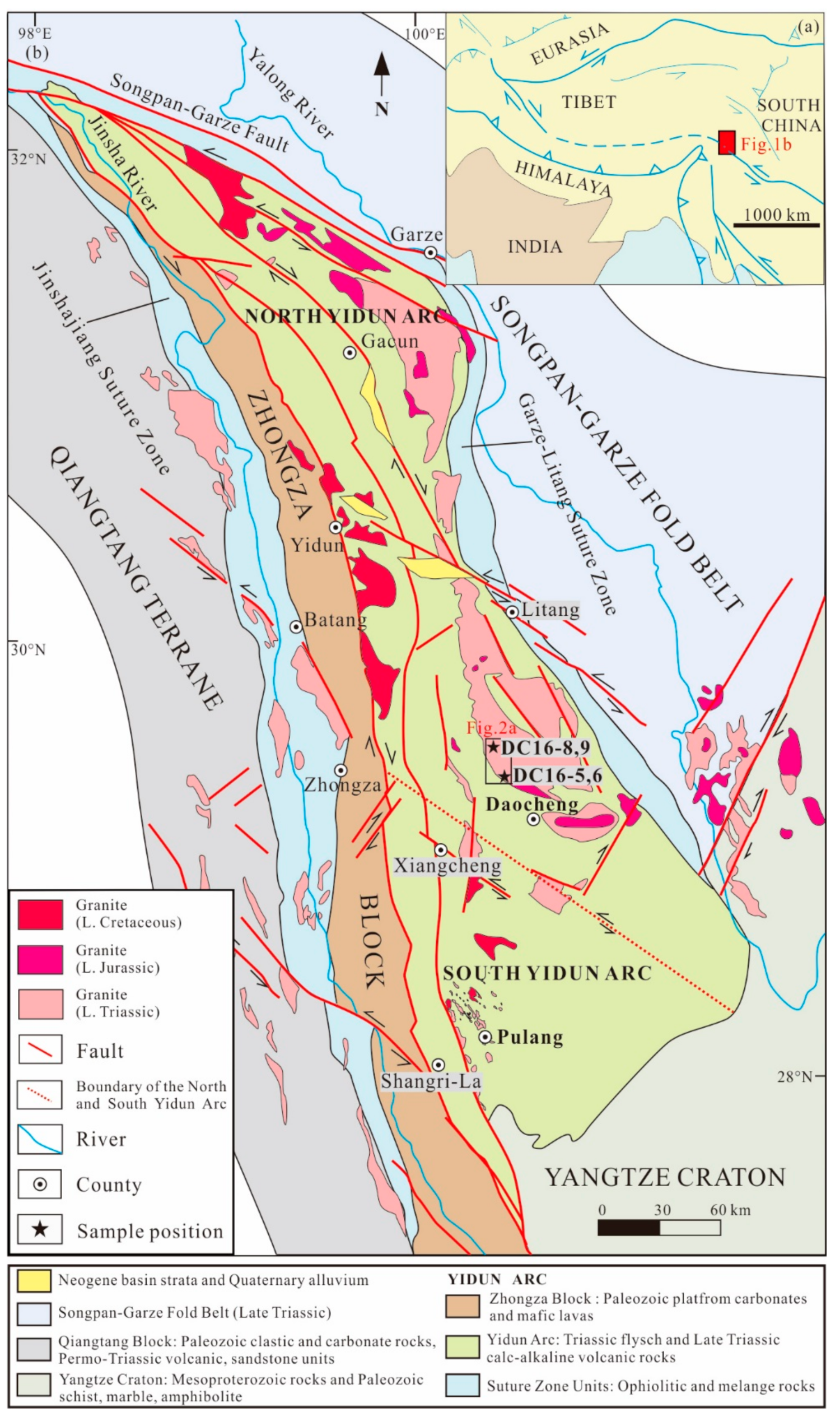

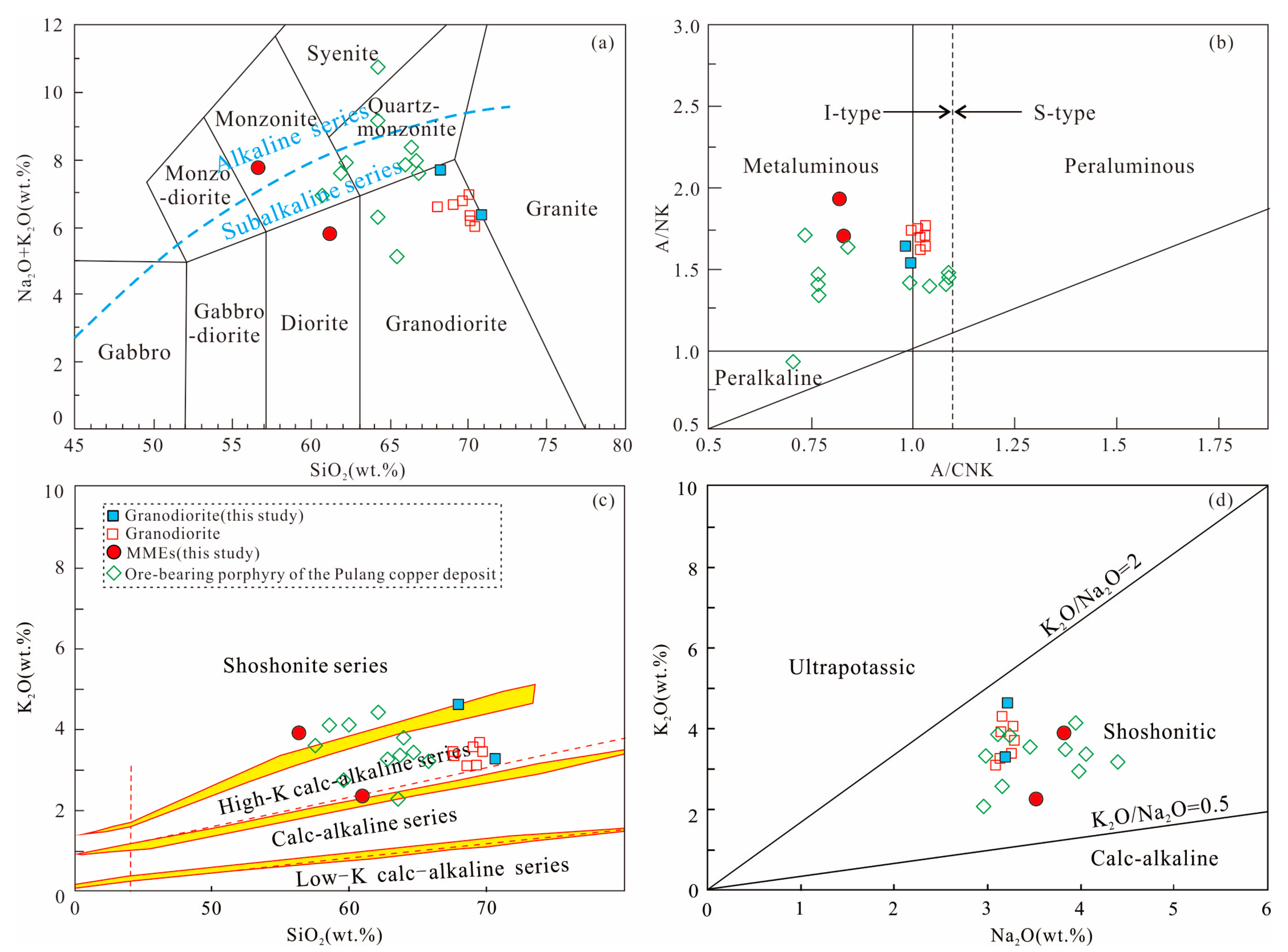
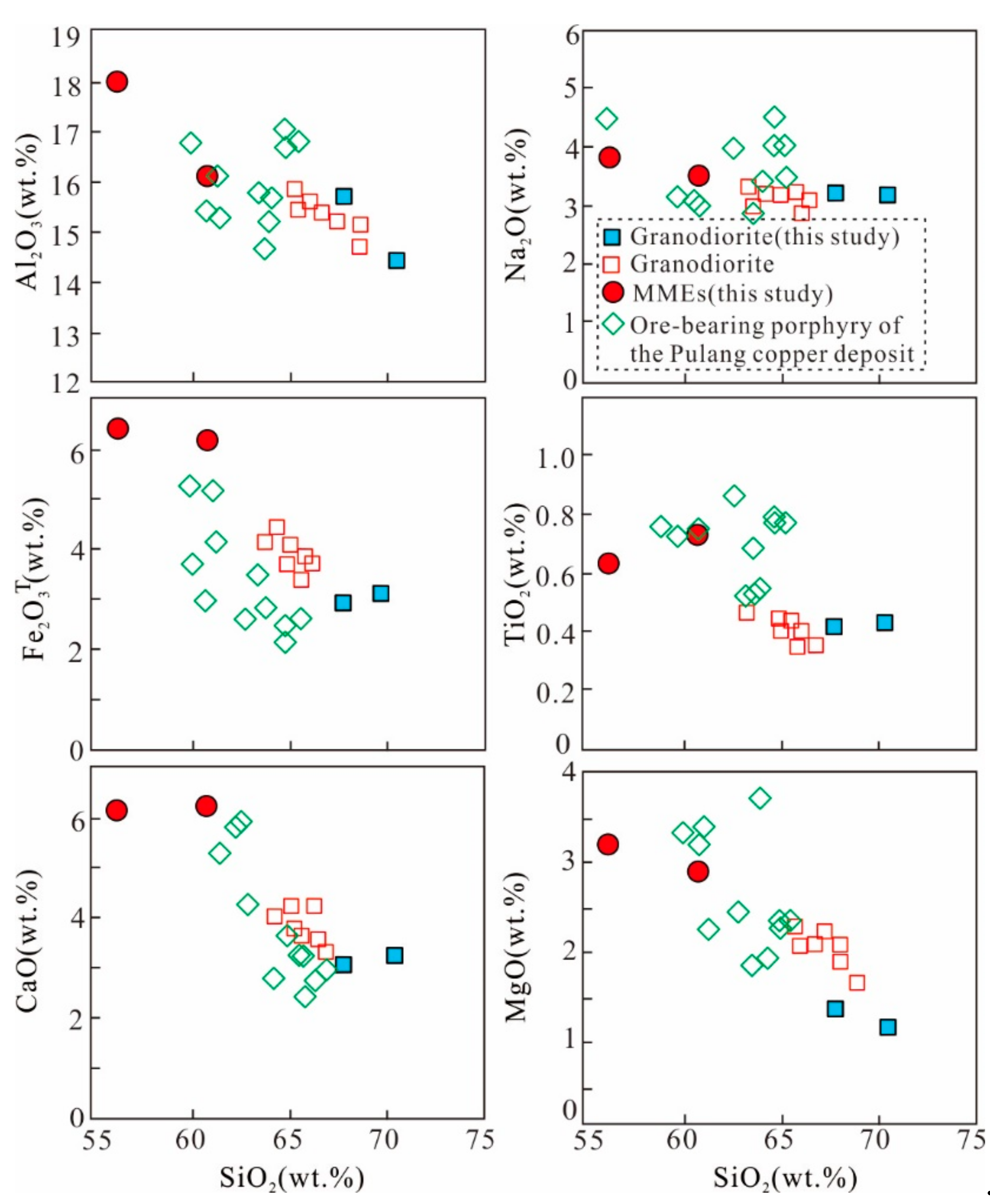
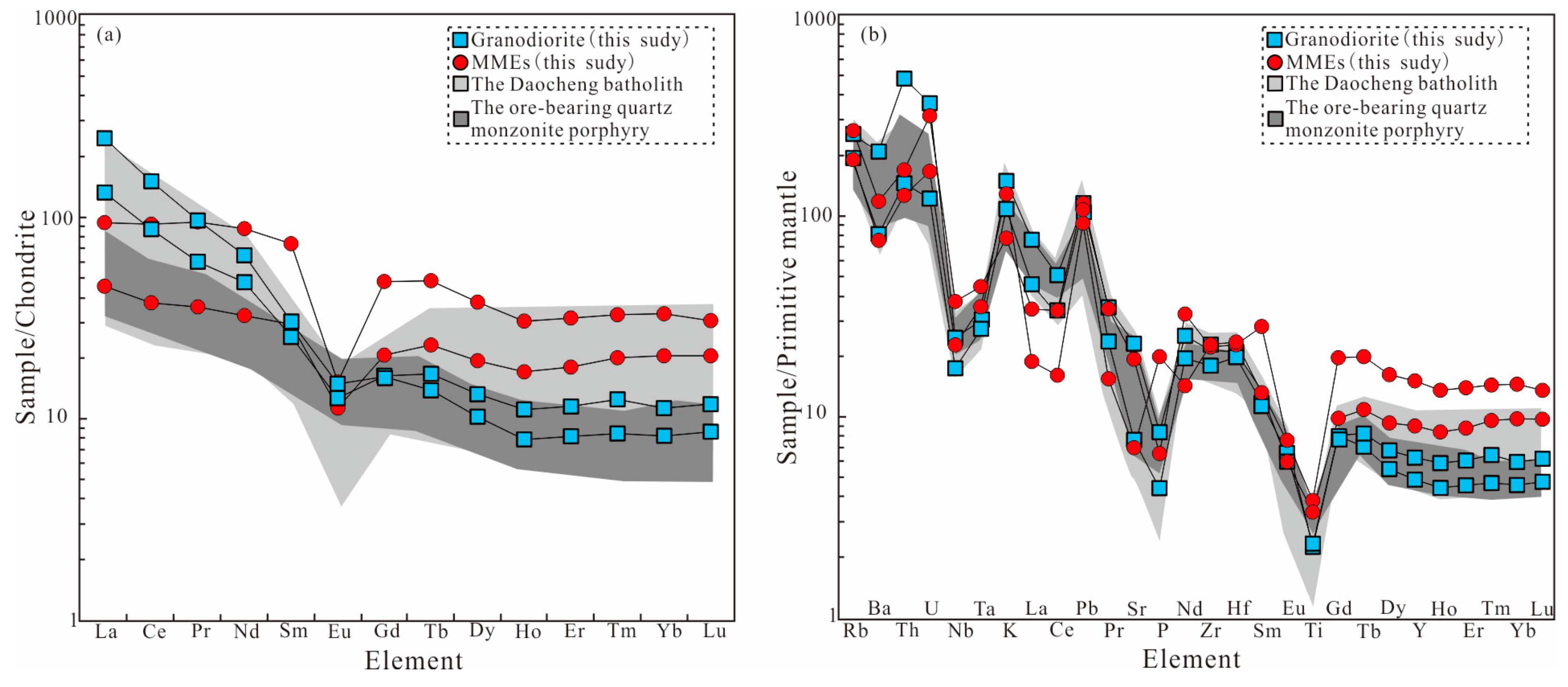
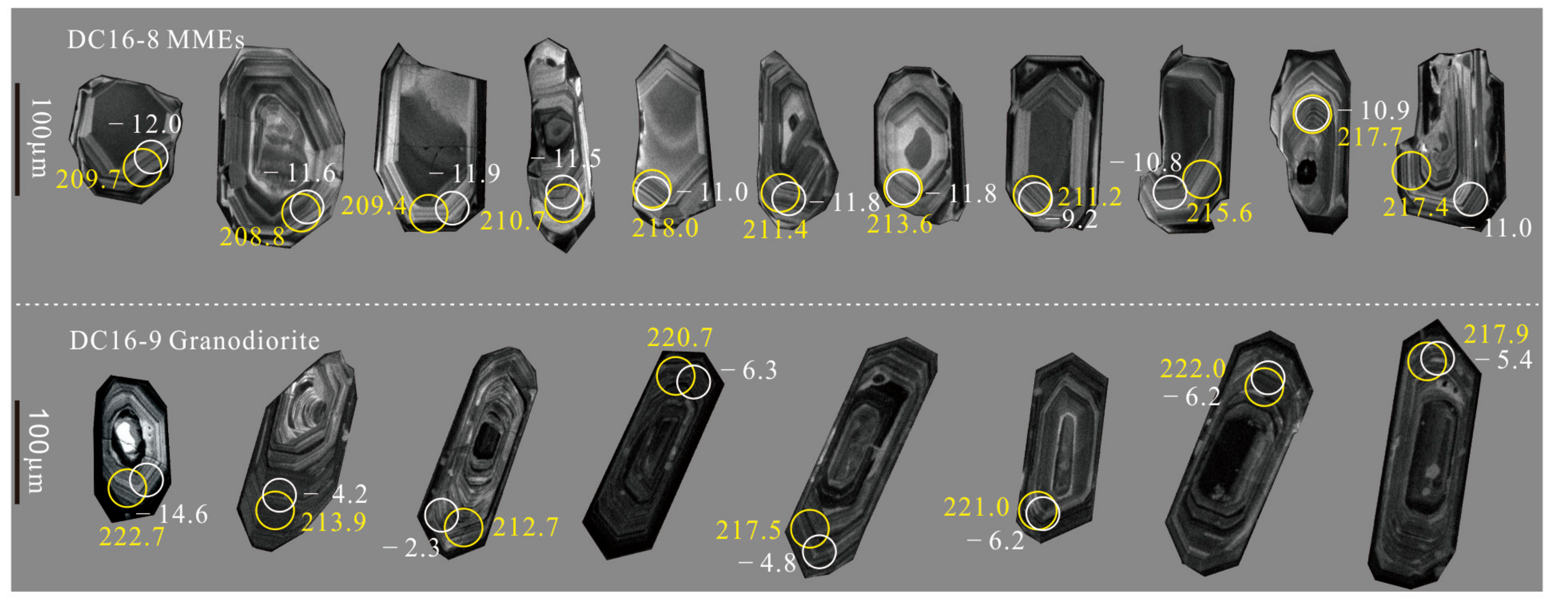

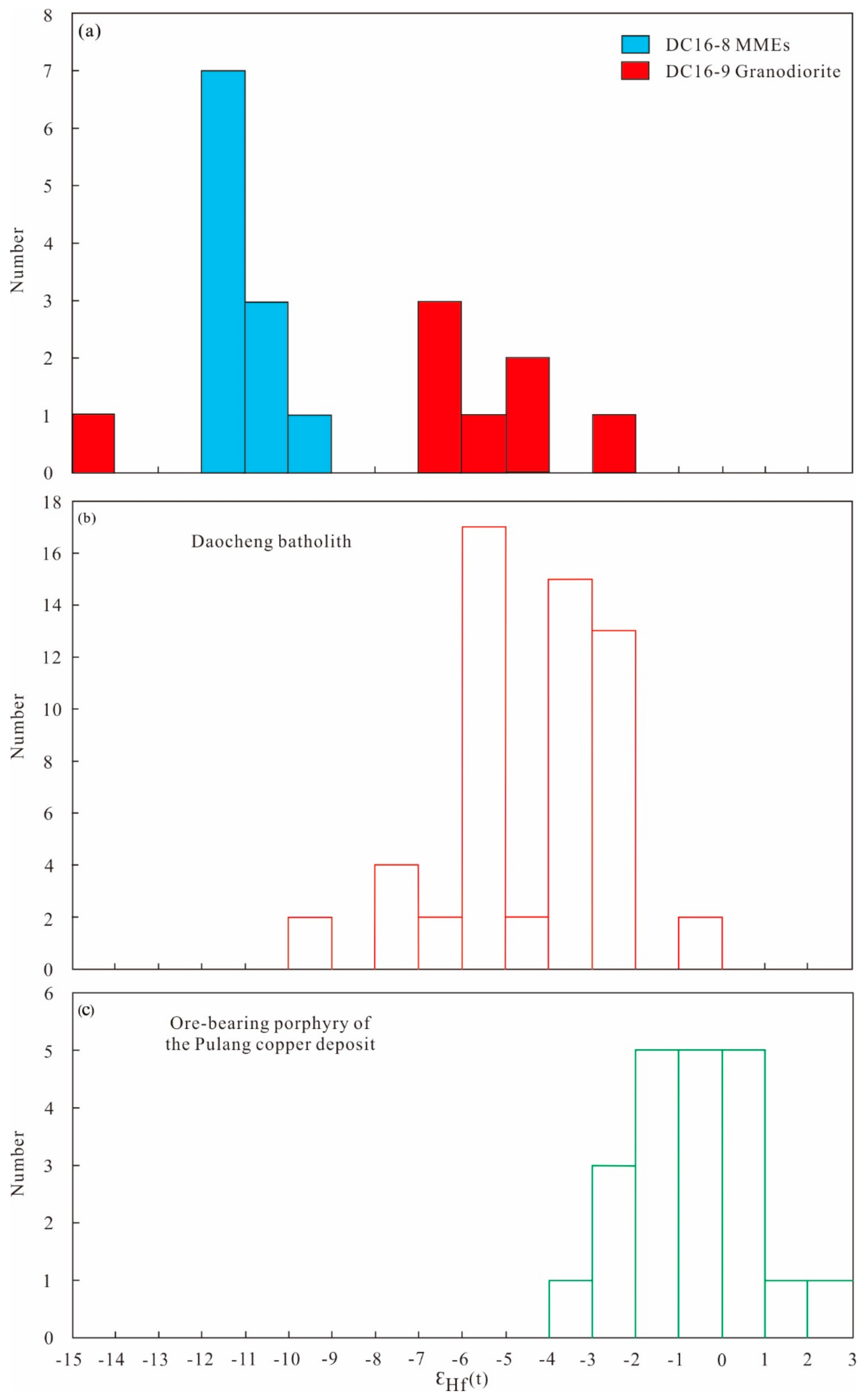
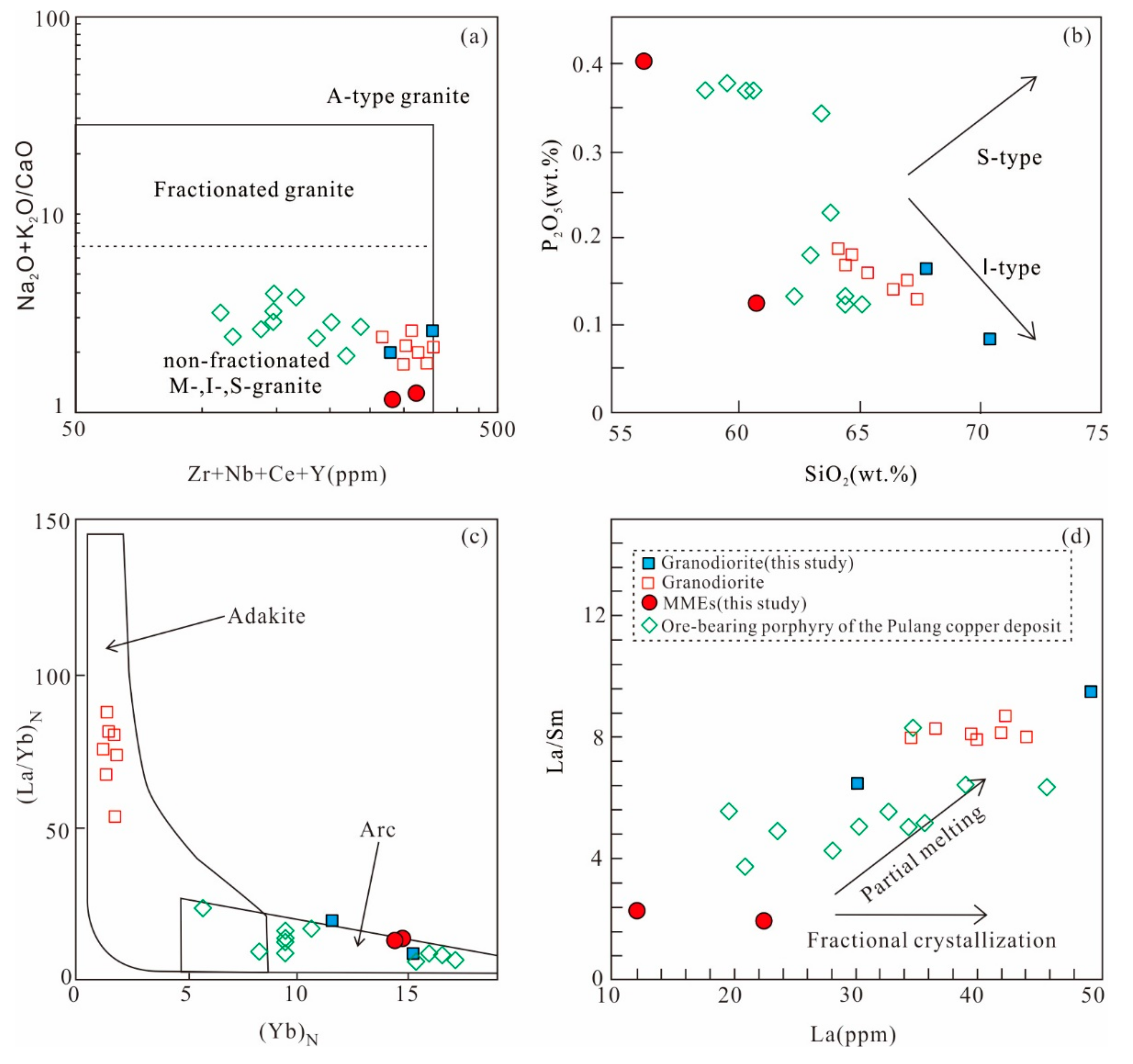
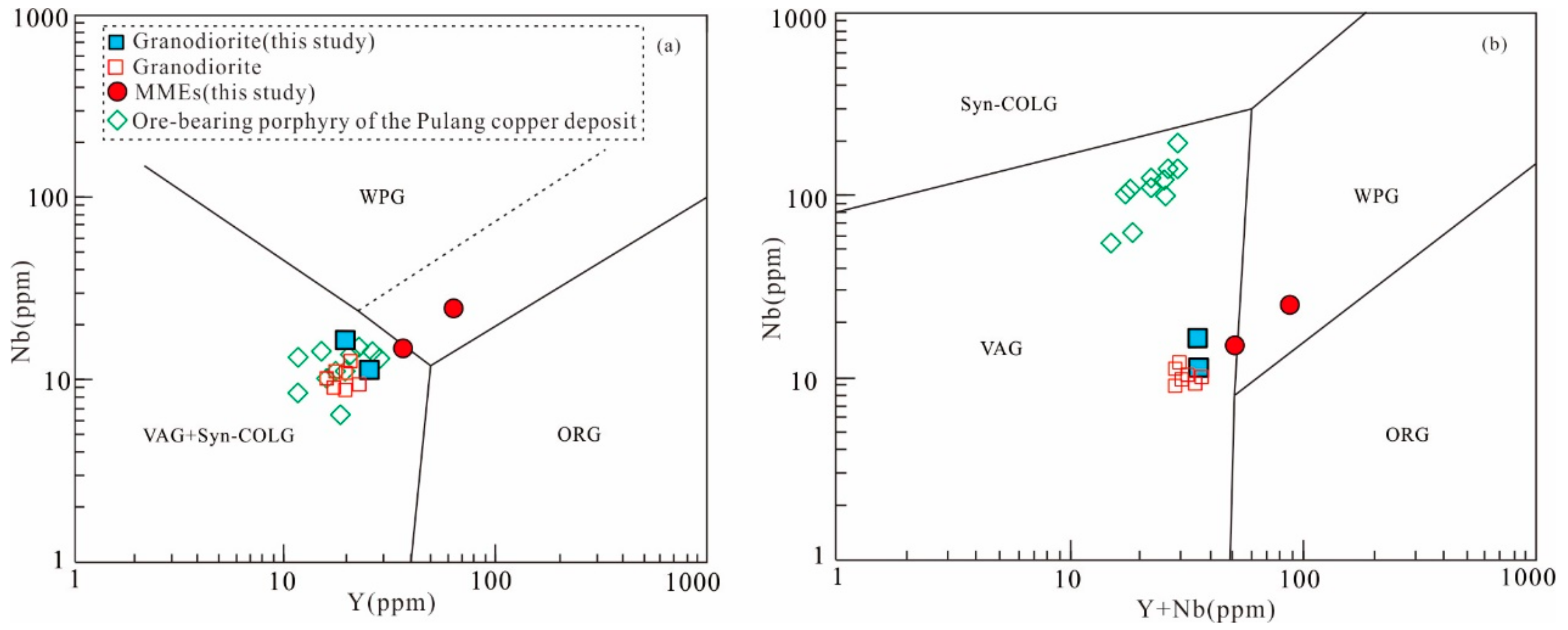
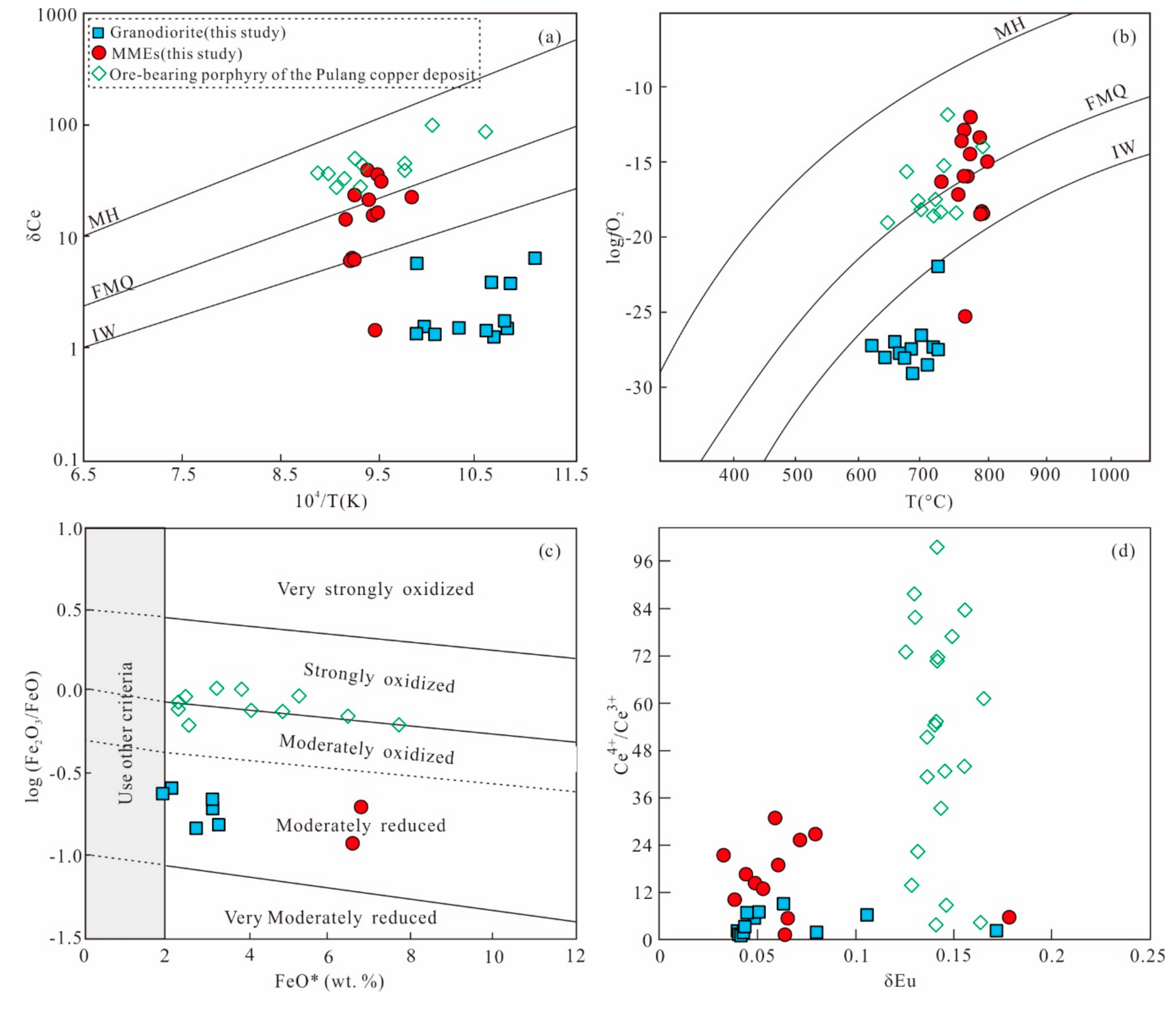
| Sample no. | DC16-6 | DC16-9 | DC16-5 | DC16-8 |
|---|---|---|---|---|
| Lithology | Granodiorite | MMEs | ||
| SiO2 | 67.90 | 70.54 | 56.34 | 60.91 |
| TiO2 | 0.41 | 0.42 | 0.62 | 0.72 |
| Al2O3 | 15.66 | 14.41 | 17.98 | 16.06 |
| FeO | 2.33 | 2.55 | 5.05 | 5.30 |
| TFe2O3 | 3.11 | 3.27 | 6.76 | 6.55 |
| MnO | 0.07 | 0.06 | 0.20 | 0.17 |
| MgO | 1.29 | 1.08 | 3.20 | 2.89 |
| CaO | 3.02 | 3.22 | 6.09 | 6.18 |
| Na2O | 3.20 | 3.18 | 3.80 | 3.50 |
| K2O | 4.59 | 3.28 | 3.93 | 2.31 |
| P2O5 | 0.16 | 0.08 | 0.40 | 0.13 |
| LOI | 0.57 | 0.43 | 0.64 | 0.57 |
| total | 99.98 | 99.98 | 99.96 | 99.98 |
| K2O + Na2O | 7.79 | 6.46 | 7.73 | 5.81 |
| K2O/Na2O | 1.43 | 1.03 | 1.03 | 0.66 |
| A/CNK | 1.00 | 0.98 | 0.83 | 0.82 |
| A/NK | 1.53 | 1.64 | 1.71 | 1.95 |
| Mg# | 45 | 39 | 48 | 46 |
| DI | 77 | 76 | 57 | 56 |
| Li | 30.5 | 30.4 | 32.5 | 40.5 |
| Be | 2.11 | 2.02 | 3.68 | 2.39 |
| Sc | 8.65 | 9.84 | 22.50 | 24.20 |
| V | 59 | 37 | 154 | 91.9 |
| Cr | 12.7 | 16.8 | 13.2 | 46.1 |
| Co | 6.10 | 6.35 | 14.20 | 14.90 |
| Ni | 6.16 | 5.19 | 12.90 | 11.60 |
| Cu | 8.22 | 4.38 | 20.60 | 16.00 |
| Zn | 39.7 | 46.8 | 74.0 | 85.5 |
| Rb | 168 | 121 | 177 | 125 |
| Sr | 457 | 144 | 379 | 131 |
| Y | 19.3 | 25.1 | 63 | 36.7 |
| Zr | 224 | 186 | 233 | 240 |
| Nb | 16.6 | 11.5 | 25.6 | 15.2 |
| Cs | 4.02 | 4.48 | 5.23 | 6.13 |
| Ba | 1516 | 562 | 834 | 522 |
| La | 51.8 | 30.3 | 22.5 | 12 |
| Ce | 87.4 | 54.4 | 57.2 | 26.3 |
| Pr | 9.24 | 6.13 | 9.08 | 3.92 |
| Nd | 32.2 | 24.6 | 41.8 | 17.7 |
| Sm | 5.47 | 4.72 | 11.8 | 5.33 |
| Eu | 1.12 | 0.97 | 1.14 | 0.88 |
| Gd | 4.26 | 4.29 | 10.90 | 5.27 |
| Tb | 0.68 | 0.80 | 2.00 | 1.06 |
| Dy | 3.54 | 4.43 | 11 | 6.16 |
| Ho | 0.63 | 0.85 | 2.03 | 1.23 |
| Er | 1.90 | 2.56 | 6.12 | 3.77 |
| Tm | 0.30 | 0.42 | 0.98 | 0.64 |
| Yb | 1.96 | 2.58 | 6.56 | 4.33 |
| Lu | 0.30 | 0.40 | 0.92 | 0.65 |
| Hf | 6.07 | 5.69 | 6.6 | 6.82 |
| Ta | 1.17 | 1.05 | 1.76 | 1.38 |
| Pb | 20.9 | 20.1 | 22.6 | 17 |
| Th | 44.3 | 12.6 | 14.8 | 10.9 |
| U | 8.14 | 2.59 | 6.99 | 3.59 |
| ΣREE | 220.11 | 162.55 | 247.02 | 125.94 |
| LREE/HREE | 5.70 | 2.92 | 1.39 | 1.11 |
| (La/Yb)N | 18.96 | 8.42 | 2.46 | 1.99 |
| Eu/Eu* | 0.68 | 0.65 | 0.30 | 0.50 |
| Sr/Y | 23.68 | 5.74 | 6.02 | 3.57 |
| Sample | Ti (ppm) | T (°C) | Ce4+/Ce3+ | 104/T (K) | δCe | Log(fO2) | △FMQ |
|---|---|---|---|---|---|---|---|
| DC16-8-02 | 11.38 | 810 | 5.70 | 9.24 | 7.49 | −17.52 | −2.98 |
| DC16-8-04 | 8.43 | 779 | 24.98 | 9.51 | 46.43 | −12.07 | 3.14 |
| DC16-8-07 | 11.88 | 814 | 5.46 | 9.20 | 7.24 | −17.44 | −3.00 |
| DC16-8-08 | 11.36 | 810 | 18.72 | 9.24 | 33.97 | −11.84 | 2.70 |
| DC16-8-11 | 9.70 | 793 | 16.41 | 9.38 | 30.14 | −13.04 | 1.86 |
| DC16-8-13 | 8.74 | 783 | 14.27 | 9.47 | 22.12 | −14.69 | 0.44 |
| DC16-8-14 | 9.22 | 788 | 12.82 | 9.43 | 20.75 | −14.68 | 0.33 |
| DC16-8-16 | 8.80 | 783 | 26.54 | 9.47 | 53.80 | −11.32 | 3.80 |
| DC16-8-18 | 9.80 | 794 | 30.52 | 9.37 | 60.57 | −10.36 | 4.51 |
| DC16-8-19 | 11.68 | 813 | 5.60 | 9.21 | 7.70 | −17.29 | −2.81 |
| DC16-8-20 | 12.57 | 820 | 9.96 | 9.15 | 18.86 | −13.58 | 0.74 |
| DC16-8-22 | 5.99 | 746 | 21.21 | 9.82 | 32.17 | −15.06 | 0.92 |
| DC16-9-02 | 5.63 | 740 | 6.59 | 9.87 | 6.76 | −21.22 | −5.09 |
| DC16-9-05 | 2.58 | 672 | 1.82 | 10.58 | 1.42 | −30.76 | −12.88 |
| DC16-9-06 | 1.98 | 651 | 6.13 | 10.82 | 4.24 | −27.90 | −9.42 |
| DC16-9-10 | 5.67 | 741 | 0.80 | 9.87 | 1.31 | −27.34 | −11.24 |
| DC16-9-12 | 0.59 | 567 | 6.57 | 11.91 | 4.99 | −32.95 | −11.74 |
| DC16-9-15 | 1.50 | 630 | 8.95 | 11.07 | 7.61 | −27.02 | −7.90 |
| DC16-9-17 | 4.59 | 721 | 1.15 | 10.06 | 1.29 | −28.41 | −11.83 |
| DC16-9-18 | 2.12 | 657 | 2.60 | 10.76 | 1.80 | −30.79 | −12.47 |
| DC16-9-19 | 3.51 | 698 | 1.80 | 10.30 | 1.50 | −29.09 | −11.91 |
| DC16-9-20 | 5.19 | 733 | 0.95 | 9.95 | 1.56 | −27.11 | −10.80 |
| DC16-9-21 | 2.46 | 668 | 5.30 | 10.62 | 4.40 | −26.74 | −8.75 |
| DC16-9-22 | 2.39 | 666 | 1.32 | 10.65 | 1.23 | −31.64 | −13.59 |
| DC16-9-23 | 2.06 | 655 | 1.87 | 10.78 | 1.47 | −31.66 | −13.28 |
© 2019 by the authors. Licensee MDPI, Basel, Switzerland. This article is an open access article distributed under the terms and conditions of the Creative Commons Attribution (CC BY) license (http://creativecommons.org/licenses/by/4.0/).
Share and Cite
Zhang, R.-G.; He, W.-Y.; Gao, X. Geochronology, Oxidization State and Source of the Daocheng Batholith, Yidun Arc: Implications for Regional Metallogenesis. Minerals 2019, 9, 608. https://doi.org/10.3390/min9100608
Zhang R-G, He W-Y, Gao X. Geochronology, Oxidization State and Source of the Daocheng Batholith, Yidun Arc: Implications for Regional Metallogenesis. Minerals. 2019; 9(10):608. https://doi.org/10.3390/min9100608
Chicago/Turabian StyleZhang, Rui-Gang, Wen-Yan He, and Xue Gao. 2019. "Geochronology, Oxidization State and Source of the Daocheng Batholith, Yidun Arc: Implications for Regional Metallogenesis" Minerals 9, no. 10: 608. https://doi.org/10.3390/min9100608
APA StyleZhang, R.-G., He, W.-Y., & Gao, X. (2019). Geochronology, Oxidization State and Source of the Daocheng Batholith, Yidun Arc: Implications for Regional Metallogenesis. Minerals, 9(10), 608. https://doi.org/10.3390/min9100608






